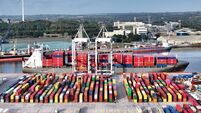Ireland at risk of missing overall 2030 climate targets, energy group warns

The Government has committed to at least 5,000 megawatts of energy coming from offshore wind by 2030.
Ireland risks missing its key overall 2030 climate improvement targets if it fails to put in place – within the next 12 months – the essential building blocks needed to progress offshore wind generation, an industry group has warned.
Launching its two-day industry conference,
Launching its two-day industry conference, Wind Energy Ireland (WEI) warned Ireland is currently not on track to deliver its planned offshore wind infrastructure and generation targets
And that could prove significantly damaging to Ireland’s overall ambition of generating 70% of its total energy from renewable sources by 2030, it said.
While suggesting it is technically possible that progress in onshore wind farms and solar energy projects might boost Ireland’s 2030 energy mix, a WEI spokesperson said: “It is very difficult to see how we can get to the 70% target” if a significant amount of planned offshore wind infrastructure isn’t up and running inside the next nine years.
The Government has committed to at least 5,000 megawatts of energy coming from offshore wind by 2030. That would be generated from about seven-10 wind farms located off the east and south coast.
Currently, only a tiny 25 megawatts of offshore energy is available from Ireland’s sole offshore wind farm – Arklow Bank 1 – off the coast of Wicklow.
WEI has reiterated the need for a proper planning process and a strengthened national grid.
However, while there has been some progress, it said there was a growing urgency for action.
WEI said there won’t be enough time to build offshore wind farms to boost the 2030 targets if “urgent action” isn’t taken over the next 12 months.
By that time, WEI said, a proper planning process needs to be put in place, an auction process for wind farm slots needs to be carried out and EirGrid – which recently carried out a consultation process on the issue – needs to communicate how it will go about strengthening the grid to accommodate renewables.
It typically takes three to four years to build a wind farm and take it to operational status; and that is after the other stepping stones such as planning and licensing are completed.
“We have less than nine years to reach the target set in the programme for government. We have a strong pipeline with more than 20,000 megawatts of offshore wind energy in various stages of development,” said Wind Energy Ireland chief executive Noel Cunniffe.
“We have the resources, the technology and the expertise. We know the target is achievable. But these projects will take time to build and we are fast running out of time.
“For us to deliver the offshore wind energy we need to decarbonise Ireland’s electricity supply we need a robust marine planning system, a much stronger electricity grid and a firm date for the first offshore renewable electricity auction,” he said.
Mr Cunniffe acknowledged the Covid crisis has slowed progress, and noted the progress that has been made on the grid and planning framework debates.
However, he warned there has been “a loss of confidence, throughout the international supply chain, that Ireland will get the key policies and legislation in place to meet its 2030 targets”.
CLIMATE & SUSTAINABILITY HUB














